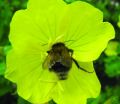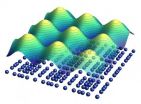(Press-News.org) New research, led by University of Warwick physicist Dr Kareem Osman, has provided significant insight into how the solar wind heats up when it should not. The solar wind rushes outwards from the raging inferno that is our Sun, but from then on the wind should only get cooler as it expands beyond our solar system since there are no particle collisions to dissipate energy. However, the solar wind is surprisingly hotter than it should be, which has puzzled scientists for decades. Two new research papers led by Dr Osman may have solved that puzzle.
Turbulence pervades the universe, being found in stars, stellar winds, accretion disks, galaxies, and even the material between galaxies. It also plays a critical role in the evolution of many laboratory plasmas, causing diminished confinement times in fusion devices. Therefore, understanding plasma turbulence is essential to the interpretation of a large body of laboratory, space, and astrophysical observations. The solar wind and near-Earth environment provide an excellent laboratory for the study of turbulence, and are the only in-situ accessible astrophysical plasmas.
The solar wind is much hotter than would be expected if it were just expanding outward from the Sun. Turbulence is the likely source of this heating. For neutral fluids such as fast flowing water, energy dissipation occurs through many microscopic collisions. As is the case for many astrophysical plasmas, the near-Earth solar wind is thin and spread out, which means collisions between particles are rare to the point that the plasma is considered collisionless. A major outstanding problem is how, in the absence of those collisions, does plasma turbulence move energy to small scales to heat the solar wind.
The new research led by Dr. Kareem Osman at the University of Warwick's Centre for Fusion, Space and Astrophysics has revealed how turbulence heats the solar wind. He says:
"Turbulence stretches and bends magnetic field lines, and often two oppositely directed field lines can come together to form a current sheet. These current sheets, which are distributed randomly in space, could be sites where the magnetic field snaps and reconnects transferring energy to particle heating. There are also many more ways that current sheets can heat and accelerate the plasma."
The researchers set thresholds in the strength of these current sheets, to determine how proton temperature was related to current sheet strength. The results show convincingly that these current sheets are associated with temperature enhancements, and that the strongest are also the hottest. While each current sheet does not provide a lot of heating, collectively the current sheets account for 50% of the solar wind internal energy despite only representing 19% of all the solar wind data. Even more striking, the strongest current sheets which only make up 2% of the solar wind were found to be responsible for 11% of the internal energy of the system.
The researchers also found that current sheets heat the solar wind in a very interesting manner; the heating is not equal in all directions.
This temperature anisotropy can drive plasma instabilities and the strongest current sheets where preferentially found in plasma that is unstable to particular types of these instabilities called 'firehose' and 'mirror'.
INFORMATION:
Notes for editors:
The University of Warwick led research was funded by The Science and Technology Facilities Council (STFC)
The two papers are:
K.T. Osman, W.H. Matthaeus, M. Wan, and A.F. Rappazzo, Intermittency and Local Heating in the Solar Wind, Phys. Rev. Lett. 108, 261102 (2012).
K.T. Osman, W.H. Matthaeus, B. Hnat, and S.C. Chapman, Kinetic Signatures and Intermittent Turbulence in the Solar Wind Plasma, Phys. Rev. Lett. 108, 261103 (2012).
For further information please contact
Dr Kareem Osman, Centre for Fusion, Space and Astrophysics, Department of Physics,
University of Warwick
Office: +44 (0)24 761 51003, Mobile/Cell number for Kareeem also availble from Peter Dunn below
Email: K.T.Osman@warwick.ac.uk
Peter Dunn, email: p.j.dunn@warwick.ac.uk
Head of Communications, Communications Office, University House,
University of Warwick, Coventry, CV4 8UW, United Kingdom
UK Tel: 024 76 523708 Mobile 07767 655860
International +44 24 76 523708 Mobile +44 7767 655860
Twitter: @PeterJDunn
PR 145 17th August 2012
END
Most people are not aware of the fact that 84% of the European crops are partially or entirely dependent on insect pollination. While managed honeybees pollinate certain crops, wild bees, flies and wasps cover a very broad spectrum of plants, and thus are considered the most important pollinators in Europe.
The serious decline in the number of managed honeybees and wild bees reported in Europe over the last few decades has the potential to cause yield decreases with threats to the environment and economy of Europe. The future of the pollination services provided by bees ...
A large-scale survey of the mental condition of military personnel before, during and after their posting to Afghanistan has proved thought-provoking. In total, 746 Danish soldiers took part in the survey. The soldiers completed a questionnaire five times in all – before their posting, during their time in Afghanistan and three times after their return to Denmark.
Professor Dorthe Berntsen of the Center on Autobiographical Memory Research – CON AMORE, Department of Psychology, Aarhus University, Business and Social Sciences, is responsible for the study, together with ...
Researchers in India have developed a total cholesterol test that uses a digital camera to take a snapshot of the back of the patient's hand rather than a blood sample. The image obtained is cropped and compared with images in a database for known cholesterol levels.
Writing in the International Journal of Medical Engineering and Informatics, N.R. Shanker of the Sree Sastha Institute of Engineering and Technology and colleagues describe how they have developed a non-invasive way to test cholesterol levels in patients at increased risk of heart disease. Their approach ...
TORONTO, Aug. 17, 2012--When members of the public participate in research studies, they are often given incentives – such as cash or gift cards for food – as compensation or reimbursement for their time and effort. Not so for Canada's prison population. A new analysis shows that there is inconsistency in how and when incentives are used for research participants under criminal justice supervision.
Of the provinces, territories and federal government, only two jurisdictions have written policy around the use of research incentives, according to a national study led by ...
Whether a material conducts electricity without losses is not least a question of the right temperature. In future it may be possible to make a more reliable prediction for high-temperature superconductors. These materials lose their resistance if they are cooled with liquid nitrogen, which is relatively easy to handle. An international team, in which physicists of the Max Planck Institute for Solid State Research in Stuttgart played a crucial role, has now discovered that this form of superconductivity competes with charge density waves, i.e. with a periodically fluctuating ...
VIDEO:
A Spanish researcher has proposed human, agricultural and livestock waste, such as urine, as a way to absorb CO2.
Click here for more information.
The ocean, the ground, rocks and trees act as carbon drains but are far from places where greenhouses gases are concentrated, especially CO2. A Spanish researcher has proposed human, agricultural and livestock waste, such as urine, as a way to absorb this gas.
Absorbing the large quantities of carbon dioxide and other greenhouse ...
EAST LANSING, Mich. --- Two new species of owls have been discovered in the Philippines, and a Michigan State University researcher played a key role in confirming their existence.
The discovery, which is featured in the current issue of Forktail, the Journal of Asian Ornithology, took years to confirm, but it was well worth the effort, said the paper's lead author Pam Rasmussen, MSU assistant professor of zoology and assistant curator of mammalogy and ornithology at the MSU Museum.
"More than 15 years ago, we realized that new subspecies of Ninox hawk-owls existed ...
CAMBRIDGE, MA -- A penny-sized rocket thruster may soon power the smallest satellites in space.
The device, designed by Paulo Lozano, an associate professor of aeronautics and astronautics at MIT, bears little resemblance to today's bulky satellite engines, which are laden with valves, pipes and heavy propellant tanks. Instead, Lozano's design is a flat, compact square — much like a computer chip — covered with 500 microscopic tips that, when stimulated with voltage, emit tiny beams of ions. Together, the array of spiky tips creates a small puff of charged particles that ...
Although George Church's next book doesn't hit the shelves until Oct. 2, it has already passed an enviable benchmark: 70 billion copies—roughly triple the sum of the top 100 books of all time.
And they fit on your thumbnail.
That's because Church, the Robert Winthrop Professor of Genetics at Harvard Medical School and a founding core faculty member of the Wyss Institute for Biomedical Engineering at Harvard University, and his team encoded the book, Regenesis: How Synthetic Biology Will Reinvent Nature and Ourselves, in DNA, which they then read and copied.
Biology's ...
NASA's Terra satellite passed over Tropical Storm Gordon as it continues to spin up in the North central Atlantic Ocean, and revealed the storm has become less symmetric, indicating it is being battered by wind shear.
When Terra passed over Gordon on August 16, 2012 at 10:25 a.m. EDT (1425 UTC) the Moderate Resolution Imaging Spectroradiometer (MODIS) instrument captured a visible image of the storm. The image showed that the bulk of Gordon's clouds were pushed to the north and northeast as a result of southwesterly wind shear. The MODIS image showed what appeared to ...



